
With 12,000 years of isolation, Tasmania is home to remarkable plants found nowhere else on Earth.
Here are a few of our favourites.
Mountain ash
Towering above its neighbours in the forest, the mountain ash (Eucalyptus regnans) holds a number of botanical records: the tallest tree species in Australia, the second tallest flowering plant in the world, and the world’s third tallest tree species (after the coast redwood and yellow meranti). The mountain ash may not be the tidiest of trees, with ribbons of bark often trailing down its trunk, but any tree that can reach a height of 100m demands awe and respect.
Where to spot them
Styx Tall Trees Conservation Area; Russell Falls track at Mount Field National Park.
Huon pine
In Tasmania, even the trees know that there’s no need to rush. The Huon pine (Lagarostrobos franklinii) is one of the slowest-growing plants in the world, taking 500 years to reach its full height of 30m, and can live for more than 2000 years. These trees – which are not members of the pine family, despite their name – played a key role in spurring European settlement in Tasmania, such was the demand for their fragrant, rot-impervious wood.
Where to spot them
Tahune Airwalk in the Huon Valley; a Gordon River cruise out of Strahan.


Leatherwood
Between January and March each year, Tasmania’s beekeepers take their hives to remote rainforests where the endemic leatherwood (Eucryphia lucida) flourishes. This is the season when sweet-smelling white flowers cover the trees like a cloak and bees make leatherwood honey. With its distinctive floral aroma and slightly spicy flavour, it’s one of Tasmania’s most prized products. Leatherwoods are found mainly on the west coast and get their name from their leathery leaves.
Where to spot them
Cradle Mountain-Lake St Clair National Park.
Buttongrass
From a distance, buttongrass (Gymnoschoenus sphaerocephalus) ripples like a sea of bronze. And like a sea, the moorlands where buttongrass flourish are also filled with life. Dragonflies float through the sharp tussocky grass, while frogs provide a soothing chorus. Buttongrass plains are among Tasmania’s most distinctive and resilient landscapes, flourishing even after bushfires, and are most commonly found in western and central Tasmania.
Where to spot them
Hartz Mountains National Park; Mount Victoria Forest Reserve near Launceston.

Pencil pine
Spot one pencil pine and you’re virtually guaranteed to find more growing nearby. That’s because the pencil pine (Athrotaxis cupressoides) reproduces by cloning, creating stands of trees that are genetically identical. These conically shaped conifers are very slow growing - typically just 12mm in diameter each year - and can live for more than 1000 years. Look for them in alpine regions close to rivers and lakes.
Where to spot them
Pencil Pine Walk near Cradle Mountain; Pine Lake walk, south of Deloraine.
Fagus
Crisp autumn mornings signal the turning of the fagus, when Tasmania's only winter-deciduous tree puts on its autumnal display. The leaves of the tangle-rooted fagus (Nothofagus gunnii), also known as the deciduous beech, usually start blazing gold and crimson around late April, although this varies from year to year and between locations. One of the ancient plants that thrived before Australia broke free of the super-continent Gondwana and drifted north to warmer climes, fagus is now found only in the cool, damp Tasmanian highlands. It's one of only a handful of winter-deciduous trees in Australia.
Where to spot them
Mount Field National Park; northern end of Cradle Mountain-Lake St Clair National Park.


Cushion plant
Resist the temptation. Cushion plants may look like invitingly soft beds of moss, but are in fact surprisingly spiky – and fragile. That is not the only deceptive thing about Tasmania’s seven species of cushion plant. What appears to be one organism is in fact a series of plants packed tightly together, all growing at the same rate to protect each other from the wind and cold. Cushion plants play a vital role in maintaining alpine landscapes, providing insulation for roots of other plants and shelter that allows other plants to germinate.
Where to spot them
Newdegate Pass in Mount Field National Park; Mount Anne Circuit in Southwest National Park.
Pandani
Its distinctive silhouette makes the pandani (Richea pandanifolia), also known as the grass bush, something of a scene-stealer. It’s not just its height that makes the tallest heath plant in the world stand out. Its serrated leaves can grow up to a metre in length and the old leaves never fall off. Instead, they drape down the stem like a petticoat. Despite the similarities in appearance, the pandani is not related to the better-known pandanus palm.
Where to spot them
Cradle Mountain-Lake St Clair National Park; Mount Field National Park.

Pandani, Hartz Mountains National Park
Wattle
The golden glow of wattle is a sure sign that winter is coming to an end, and in Tasmania that includes the flowers of several indigenous species. Look for the Derwent wattle (Acacia derwentiana), which grows along the banks of the River Derwent, the Midlands wattle (Acacia axillaris) and the silver wattle (Acacia dealbata).
Where to spot them
Mount William National Park; Ben Lomond National Park.
Scoparia
When a bracing alpine wind starts gusting during your hike, chances are you’ll see scoparia (Richea scoparia) nearby. This prickly bush flourishes in exposed conditions, but is best admired at a distance - its spines rip clothes and skin. Unusually, it’s pollinated by lizards rather than bees. Scoparia blooms between January and March, when its many-petalled flowers form an Impressionist landscape in shades of orange, yellow, red, pink and white.
Where to spot them
Cradle Mountain-Lake St Clair National Park; Ben Lomond National Park.
Caring for plants
Follow a few steps to keep the wilderness wild.
Leave plants, rocks, shells and other natural objects as you find them.
Take hiking poles rather than using branches as walking sticks. Avoid walking or camping on vegetation. Instead, camp at established sites and platforms, and walk on established tracks, gravel, rocks and snow.
Walk single file in the middle of the track – even through muddy bogs and puddles. Don’t skirt around muddy sections; it damages trackside vegetation and alters the track.
Make sure your boots, camping equipment and tyres are clean and free of seeds to avoid spreading weeds and soil-borne diseases. And dispose of waste properly - whatever you bring into natural areas, take it away.















